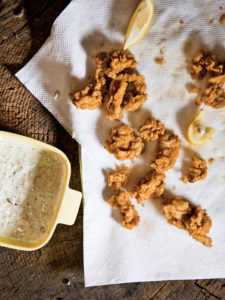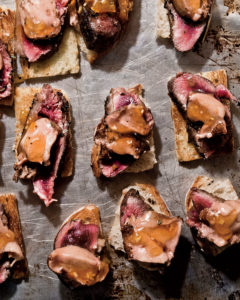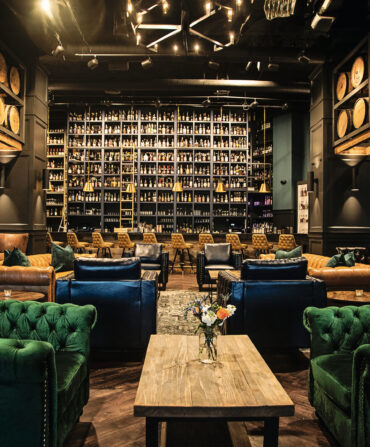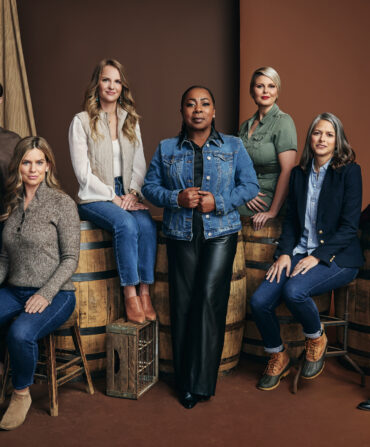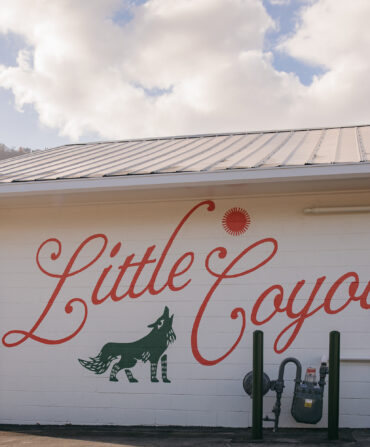Food & Drink
For the Love of the Game
When a group of the South’s finest chefs gather for a hunt, the only thing better than the camaraderie is the cooking
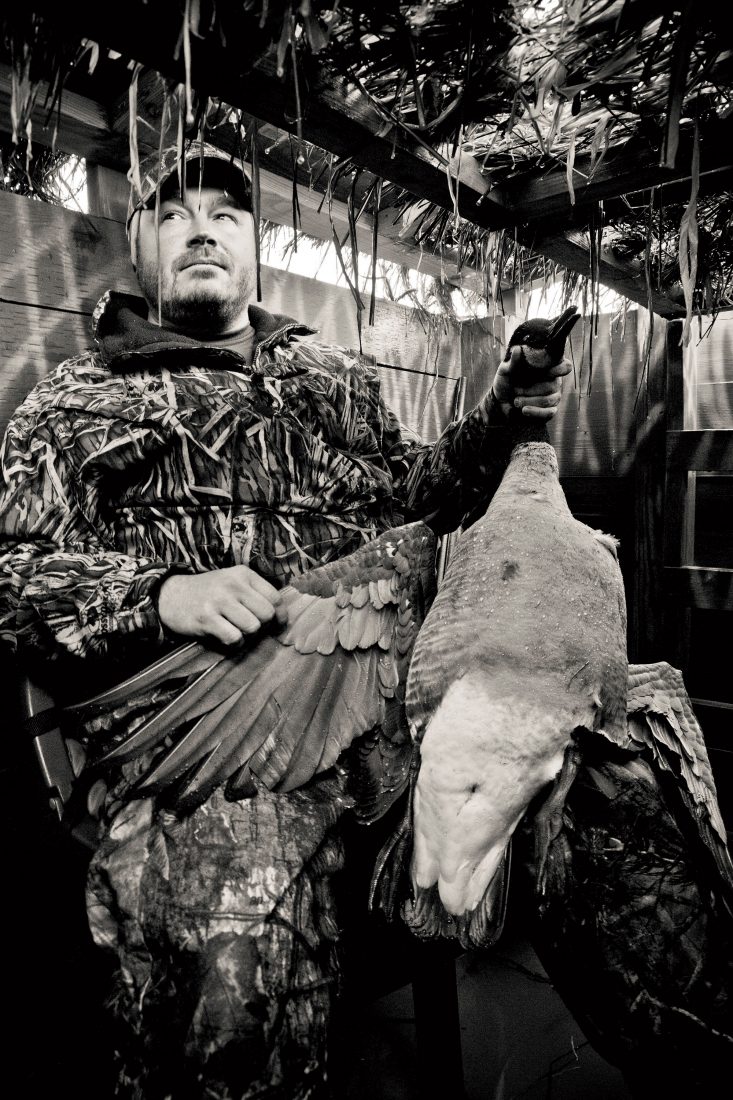
Photo: Peter Frank Edwards
I’ve never been good at calling in Canada geese.
It requires a certain stream of breath into the cylindrical wooden call, which then issues from the far end a scratchy, grainy, pebbled “grank.” I’ve never been able to get it right.
Fortunately, I am seated next to Tom Gallivan in a blind on a historic farm on the James River, about forty minutes east of Richmond, Virginia. Gallivan runs Shooting Point, perhaps the best-known high-end purveyor of oysters, clams, and blue crabs on Chesapeake Bay. Outside of our partially buried blind, it is cold and raining. This is great, as a low cloud ceiling generally keeps the ducks and geese lower to the ground. But also, inside of our blind it’s cold and raining. The roof leaks like an old rowboat, and there is now a lot of standing water. Gallivan was smart enough to wear neoprene wading boots, but I’m not as appropriately attired. In the thirty-eight-degree weather I am shivering so much it sometimes feels like I’m dancing. Several of the best chefs in the South wait in blinds nearby, having gathered for a hunting trip before hosting a feast in Richmond for the James Beard Foundation this weekend. At the moment, we’re about as far from a James Beard Foundation dinner as you can get.
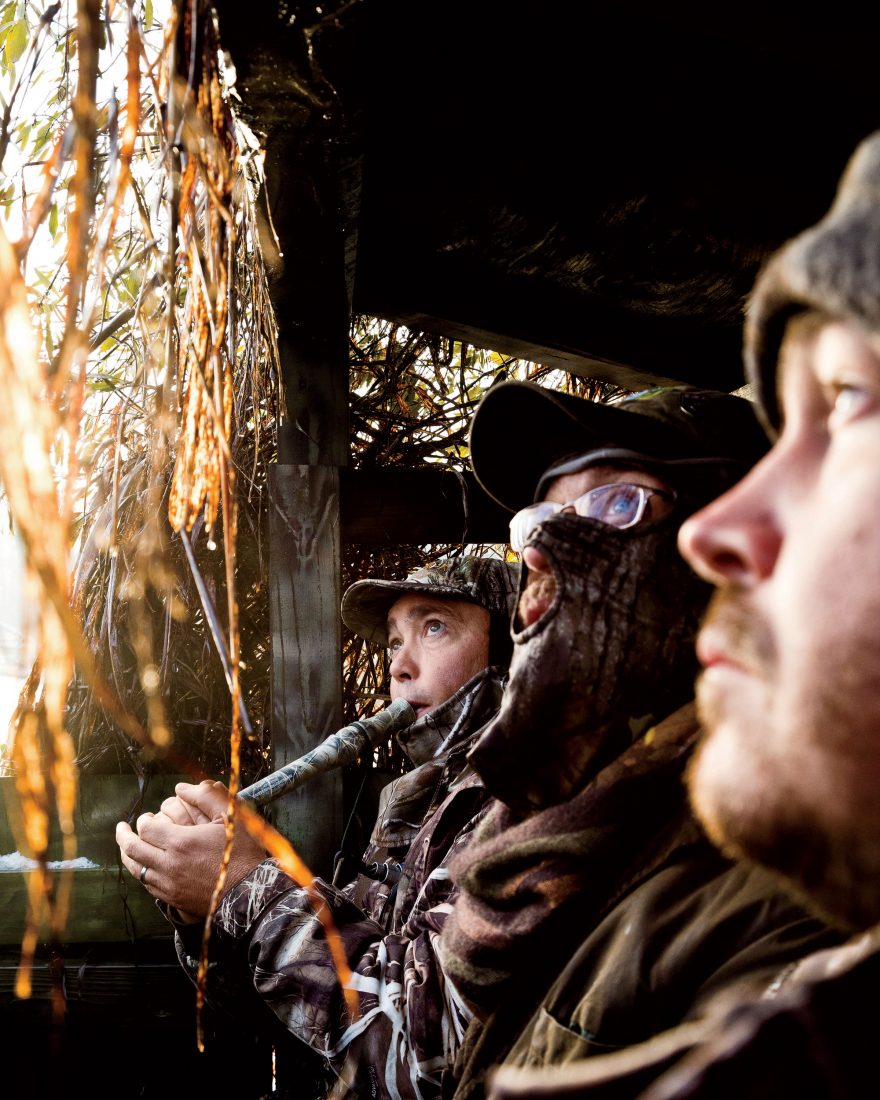
Photo: Peter Frank Edwards
Eyes on the Sky
Walter Bundy works a goose call while Chris Hastings and Sean Brock wait for the birds to drop in.
A few hundred yards down to our left, from another blind on the property, shots are fired. Gallivan looks to his left and scans the sky. He spots a flight of Canada geese coming in. He lifts his shotgun: a black Benelli 12-gauge. “Let’s get ready,” he says. “Here they come.”
It’s the first afternoon of a two-day hunt at the farm, a spread of several hundred acres owned by the

Photo: Peter Frank Edwards
Geese in flight.
family of chef Walter Bundy’s wife. Bundy—a Virginia native formerly of the French Laundry in California’s Napa Valley—now presides over the kitchen at Lemaire restaurant, at Richmond’s famed Jefferson hotel, and he has kindly thrown this whole affair together. Despite the icy weather, the place is lovely: a sumptuous and giant old Georgian house plugged into a wonderfully stately setting that, beginning in the 1970s, has been completely restored. The property is rife with pastoral landscapes and plush rooms, backdropped by the enormous tidal estuary breadth of “the River,” as they call the James around here.
A more capable hunting and cooking crew you could hardly hope to assemble. The chefs in our party include Sean Brock (of McCrady’s and Husk in Charleston, South Carolina, and now Nashville), Chris Hastings (of Hot and Hot Fish Club in Birmingham, Alabama), and Sam McGann (of the Blue Point in Duck, North Carolina). Today began with arrivals at Richmond’s airport, then pork barbecue for lunch, then hunting in the afternoon. Tomorrow, after the hunt is finished, we’ll drive back to Richmond, where the chefs will host a Mid-Winter’s Feast, a benefit for the James Beard Foundation and the Lemaire Scholarship for aspiring chefs. But mostly, while off duty, these are just guys who like and respect one another and appreciate the significance of bagging dinner.
“For me, hunting is about paying respect to the animal,” Bundy says. “That’s why I started cooking, to pay respect to these beautiful animals and use them to their fullest potential. There’s no better food in the world. It’s unadulterated, untouched, and as natural as it comes.”
A few hours after the hunt is finished, and following a warm-up beer, it’s time to get down to business. The shooting for the day was marginal. The ducks and geese were edgy, mainly long shots. But now comes the day’s culmination: cooking in the hunt shed, which is several hundred yards away from the white-painted main house over low, rolling lawns. The hunt shed has a small but efficient kitchen, and several hardwood or charcoal smoker tubs outside. It doesn’t look like the haunt of celebrated chefs, particularly. But looks can be deceiving.
As the indoors heats up from the cookstove, we are in the midst of “chicken-frying” some of Gallivan’s Shooting Point oysters, to be served with a roasted garlic–dill pickle sauce.
“I’m a good chef, and I’ve worked in some good places, but I wanted to invite guys who are incredible chefs, to make it a level playing field,” Bundy says.
This evening, the oysters are just the beginning. Out comes smoked goose breast, then pheasant breast in a tempura bath with a Coca-Cola barbecue sauce, then venison loin wrapped in bacon, then mallard breasts seared in a cast-iron skillet. It’s all ridiculously tasty.
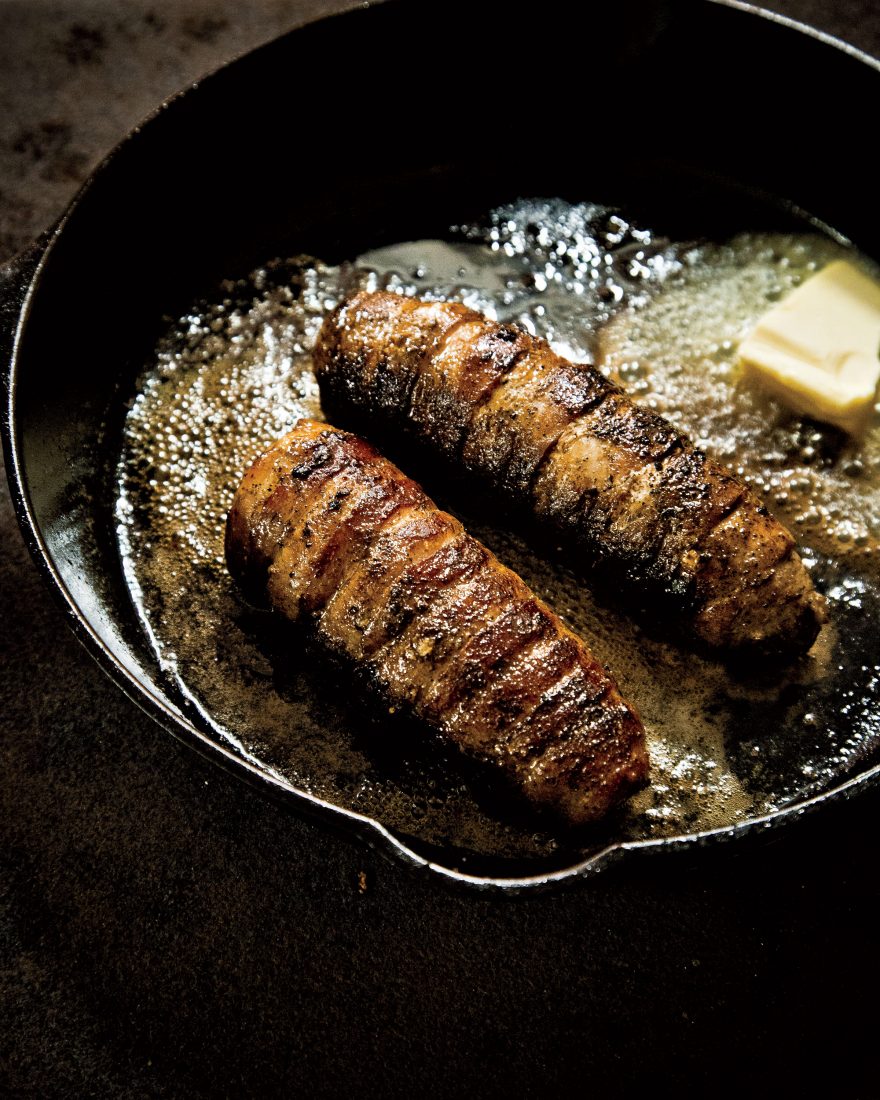
Photo: Peter Frank Edwards
Field Feast
Bacon-wrapped venison loin.
“Hey,” Bundy says at one point, coming toward me from the hunt shed’s refrigerator with a knife in hand. “Try this. Put a little orange marmalade on top.” He slaps a pat of marmalade on top of my duck. “It helps the taste move along.”
The chefs are all kibitzing, cooking, and just playing with flavors. “We cook, talk a little bit of shop, talk a little bit of life,” Hastings says. “That’s how it always is.”
There’s a lot of laughing, too. We’re having beers or lethal old-fashioneds served up by Brock and Hastings and McGann. We’re all still trying to get completely warm.
For dessert, we have Tom Gallivan’s steamed oysters and clams, which have been curing outdoors on the wood smoker for a while. The chefs are letting their hair down. They’re grousing about the
food in some of America’s most reputable restaurants. Even about the service at their own places.
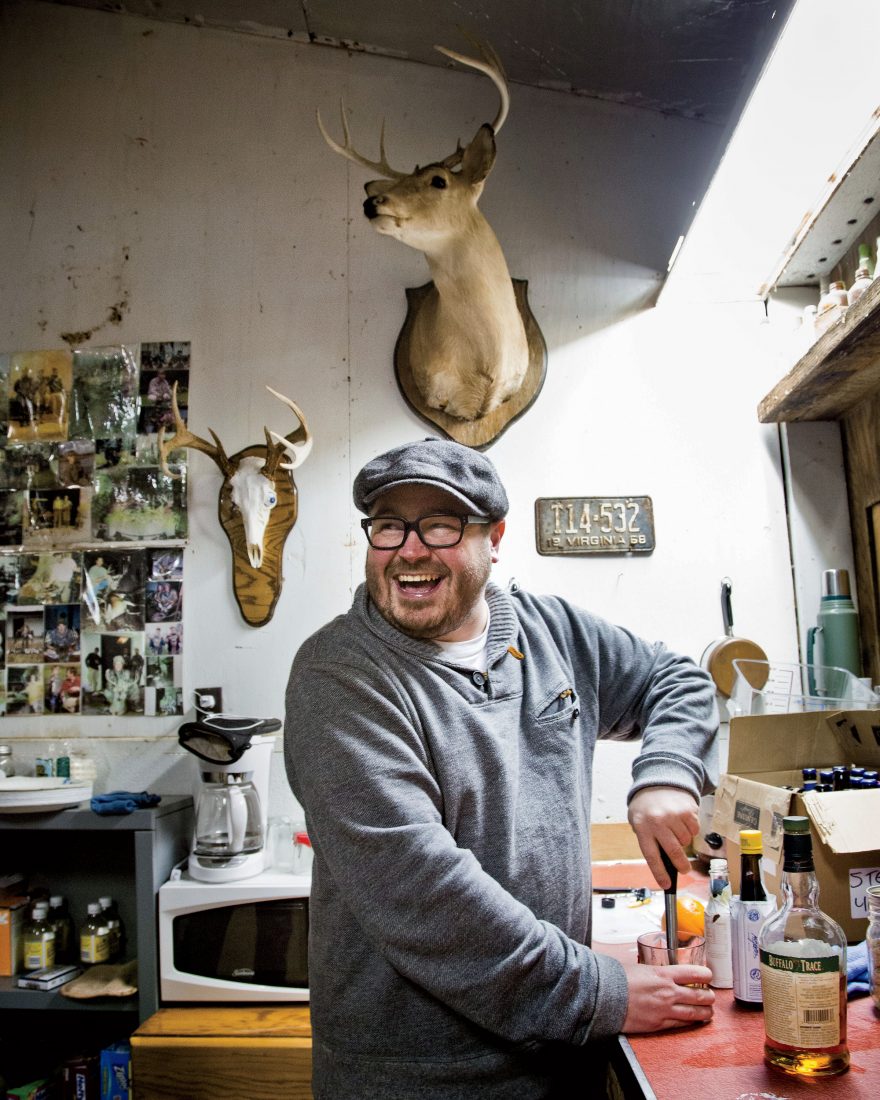
Photo: Peter Frank Edwards
Brock whips up a drink in the hunt shed.
Here’s Sean Brock: “One night, I went to my own restaurant to have a dinner with my fiancée, and nothing was right,” he says. “I got wine spilled on me, and the food didn’t come. And when it did, it wasn’t right.” He’s wearing a Southern Foodways Alliance T-shirt that reads, “MAKE CORNBREAD NOT WAR.” On that occasion, he made war, not cornbread. “But that’s what it takes to make a good restaurant.”
These guys take food (and the gathering of it and the people who enjoy it) very seriously. “When it was time for me to open my own restaurant, I knew what I wanted it to be,” Hastings says. “I wanted to be a chef who lived in close proximity to the land and the water. I live seasonally. I cook seasonally. That’s the way I grew up, and it’s informed my cooking.”
While I go to bed about 10:00 p.m., it’s fair to say that the eating and storytelling carry on long past midnight.
The following morning the shooting is better. The chefs limit out with geese and several ducks before lunch. Then we go back to the house, pack our bags, and head for Richmond.
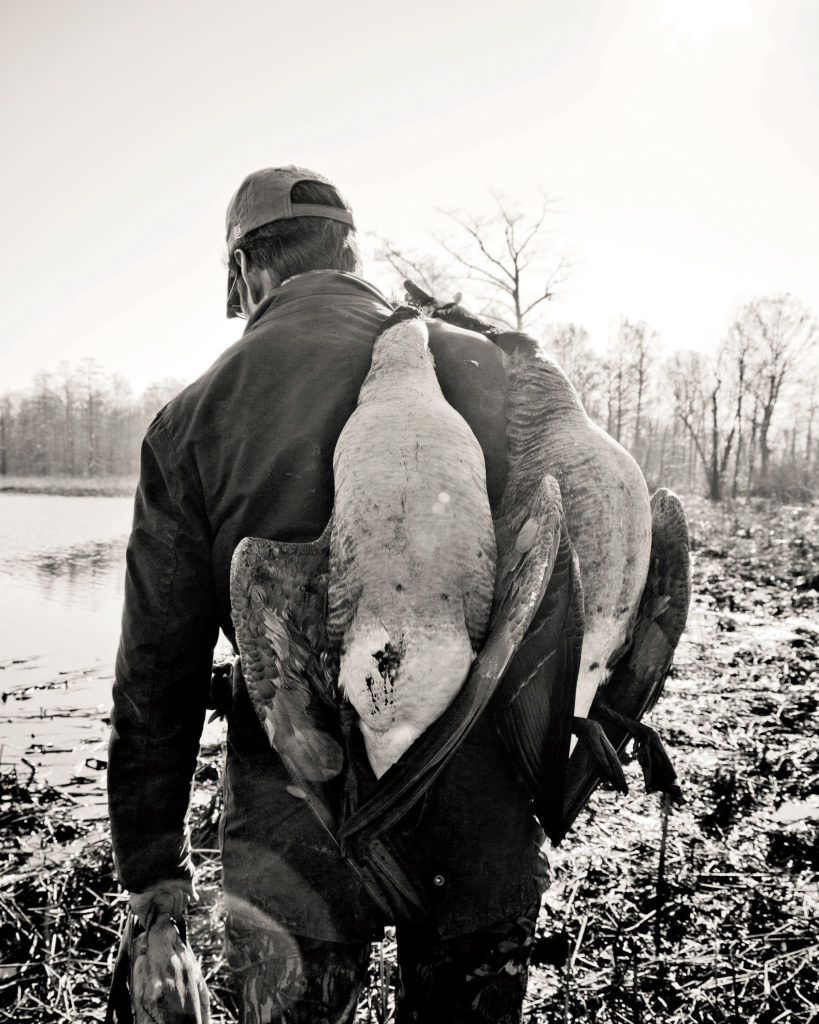
Photo: Peter Frank Edwards
Hastings hauls home dinner.
As the dinner approaches the next afternoon, none of the chefs are screwing around. The hors d’oeuvres alone are amazing. Smoked trout on a blini with crème fraîche from McGann, and Bundy’s Duck, Duck, Goose (a tiny pile of smoked goose, duck foie gras, apple butter, and candied pecans on toast). Then it’s time to sit and eat. Here come Brock’s jumbo blue crab with apples and black butter, snapper jowl from Hastings, and McGann’s braised rabbit, followed by Bundy’s pork and beans (which, for the record, is far more sophisticated than its Hormel-style moniker suggests).
At one point, just to say hello and thank you, I step back into the kitchen to find Bundy. When I see him amid all the steel tables and cooking ranges, he’s busy. He looks to his left and says: “I can’t talk right now…really.” Like all the other chefs around over the last couple of days, Walter Bundy is dead serious about his food.



